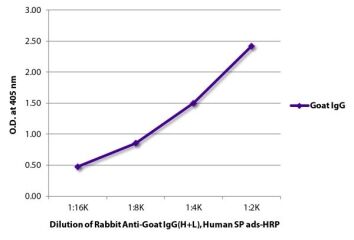Rabbit Anti-Goat IgG(H+L), Human SP ads-HRP
Referência 6164-05
Tamanho : 1.0mL
Marca : Southern Biotech
| Isotype | Rabbit IgG |
|---|---|
| Isotype Control | 0111-05 |
| Specificity | Reacts with the heavy and light chains of goat IgG |
| Source | Pooled antisera from rabbits hyperimmunized with goat IgG |
| Cross Adsorption | Human serum proteins (SP); may react with immunoglobulins from other species and the light chains of other goat immunoglobulins |
| Purification Method | Affinity chromatography on goat IgG covalently linked to agarose |
| Conjugate | HRP (Horseradish Peroxidase) |
| Buffer Formulation | 50% Glycerol/50% Phosphate buffered saline, pH 7.4 |
| Clonality | Polyclonal |
| Concentration | Lot specific |
| Volume | 1.0 mL |
| Recommended Storage | 2-8°C |
| Applications | Quality tested applications for relevant formats include - ELISA 1 FLISA Other referenced applications for relevant formats include - Flow Cytometry 2-6 Immunohistochemistry-Frozen Sections 7 Immunohistochemistry-Paraffin Sections 8-10 Immunocytochemistry 11 Western Blot 12-14 |
| RRID Number | AB_2796238 |
Documentation
Technical Bulletin Safety Datasheet
Certificate of Analysis Lookup
Enter the Catalog Number and Lot Number for the Certificate of Analysis you wish to view
- 1. Boxx GM, Kozel TR, Nishiya CT, Zhang MX. Influence of mannan and glucan on complement activation and C3 binding by Candida albicans. Infect Immun. 2010;78:1250-9. (ELISA)
- 2. Fu S, Gong F, Xie C, Zhu W, Wang W, Shen H, et al. S100A12 on circulating endothelial cells surface in children with Kawasaki disease. Pediatr Res. 2010;68:165-8. (FC)
- 3. Rezaee F, Rellick SL, Piedimonte G, Akers SM, O'Leary HA, Martin K, et al. Neurotrophins regulate bone marrow stromal cell IL-6 expression through the MAPK pathway. PLoS One. 2010;5(3):e9690. (FC)
- 4. Sekiya I, Ojima M, Suzuki S, Yamaga M, Horie M, Koga H, et al. Human mesenchymal stem cells in synovial fluid increase in the knee with degenerated cartilage and osteoarthritis. J Orthop Res. 2012;30:943-9. (FC)
- 5. Gong F, Zhang Y, Xie C, Zhu W, Wang W, Fu S, et al. Expression of receptor for advanced glycation end products (RAGE) on the surface of circulating endothelial cells is upregulated in Kawasaki disease. Pediatr Res. 2012;71:720-4. (FC)
- 6. Hegde M, Corder A, Chow KK, Mukherjee M, Ashoori A, Kew Y, et al. Combinational targeting offsets antigen escape and enhances effector functions of adoptively transferred T cells in glioblastoma. Mol Ther. 2013;21:2087-101. (FC)
- 7. Kreft KL, Verbraak E, Wierenga-Wolf AF, van Meurs M, Oostra BA, Laman JD, et al. The IL-7Rα pathway is quantitatively and functionally altered in CD8 T cells in multiple sclerosis. J Immunol. 2012;188:1874-83. (IHC-FS)
- 8. Crijns AP, de Graeff P, Geerts D, ten Hoor KA, Hollema H, van der Sluis T, et al. MEIS and PBX homeobox proteins in ovarian cancer. Eur J Cancer. 2007;43:2495-505. (IHC-PS)
- 9. Ando K, Brion J, Stygelbout V, Suain V, Authelet M, Dedecker R, et al. Clathrin adaptor CALM/PICALM is associated with neurofibrillary tangles and is cleaved in Alzheimer's brains. Acta Neuropathol. 2013;125:861-78. (IHC-PS)
- 10. Ahmed L, Nalwoga H, Arnes JB, Wabinga H, Micklem DR, Akslen LA. Increased tumor cell expression of Axl is a marker of aggressive features in breast cancer among African women. APMIS. 2015 May 25. doi: 10.1111/apm.12403. [Epub ahead of print]. (IHC-PS)
- 11. Hosper NA, van den Berg PP, de Rond S, Popa ER, Wilmer MJ, Masereeuw R, et al. Epithelial-to-mesenchymal transition in fibrosis: collagen type I expression is highly upregulated after EMT, but does not contribute to collagen deposition. Exp Cell Res. 2013;319:3000-9. (ICC)
- 12. Rayes J, Roumenina LT, Dimitrov JD, Repessé Y, Ing M, Christophe O, et al. The interaction between factor H and VWF increases factor H cofactor activity and regulates VWF prothrombotic status. Blood. 2014;123:121-5. (WB)
- 13. Wu X, Sagave J, Rutkovskiy A, Haugen F, Baysa A, Nygård S, et al. Expression of bone morphogenetic protein 4 and its receptors in the remodeling heart. Life Sci. 2014;97:145-54. (WB)
- 14. Matsebatlela TM, Anderson AL, Gallicchio VS, Elford H, Rice CD. 3,4-Dihydroxy-benzohydroxamic acid (Didox) suppresses pro-inflammatory profiles and oxidative stress in TLR4-activated RAW264.7 murine macrophages. Chem Biol Interact. 2015;233:95-105. (WB)






